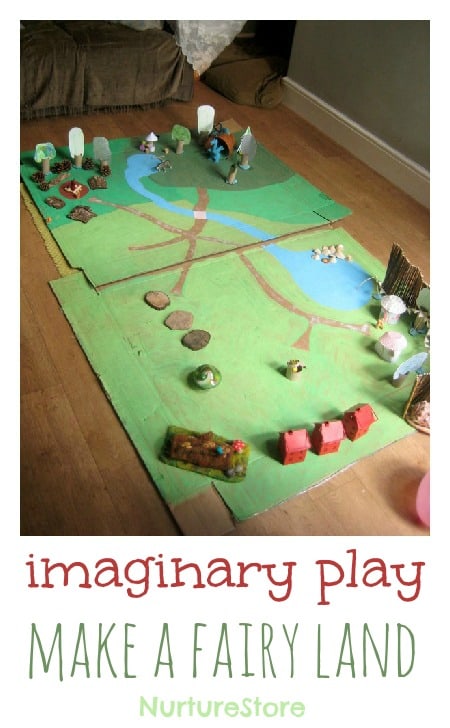Today’s invitation in the Stay at Home, Screen Free Activities Programme is all about play dough.
Never made it before? Run out of ideas for something new?
Here are my top ten play dough ideas – and an easy recipe for homemade playdough.
by Cathy James
Today’s invitation in the Stay at Home, Screen Free Activities Programme is all about play dough.
Never made it before? Run out of ideas for something new?
Here are my top ten play dough ideas – and an easy recipe for homemade playdough.
by Cathy James
Learning to use scissors can take lots of practise. We can incorporate scissor skills as part of our every day activities, such as helping to chop herbs to go with our dinner, or include them in our play and learning activities. Here’s a collection of ideas you can use to encourage your child to work on their scissor skills through art, craft, math, and sensory invitations to play.
by Cathy James
A play dough pizza parlour is a fun sensory play activity that encourages lots of imaginary play and conversation skills.
Click play on the video above to see our playdough masterclass.
This video gives you everything you ever wanted to know about play dough: how to make homemade playdough with quick and easy recipes; the benefits of playdough for children; and lots of sensory play activities using play dough including playdough math activities, playdough literacy activities, and playdough fine motor skills activities.
Plus find out how to get printable playdough recipe cards and printable play mats. It’s an excellent beginners guide to play dough!
Subscribe to NurtureStore’s YouTube channel to get more gardening and nature study videos!
Play dough is such a good material to use in pretend play. With a child’s imagination play dough can be turned into just about anything.
It adds a extra sensory dimension into their play and really it’s not too messy to tidy up, so you can use it in the dolls house, play kitchen, home corner, train set, garden… wherever!
This week my girls have been having a fabulous fun time using play dough to make pizzas. Yesterday Janet Lansbury wrote that play is enough and I thought I’d show you how this works in our house.
A simple batch of play dough plus a few added extras turns into hours of play with math, science, language and social skills incorporated naturally as part of the children’s play.
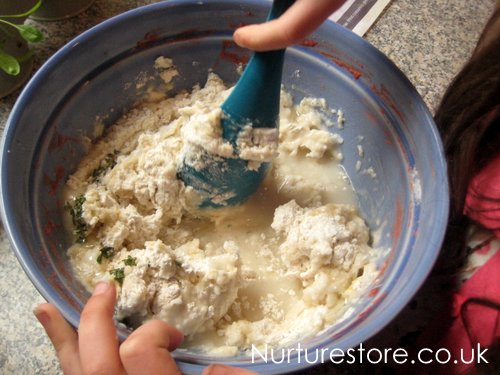
We started by making some play dough of course. We made our easy no cook play dough recipe for our pizza dough, adding in some herbs from the garden for extra sensory fragrance: rosemary and oregano are great pizza smells.
We also made a batch of play dough with red food colouring in, which was to be the tomato sauce topping on our pizzas.
What children are learning about as they play:
:: reading a recipe
:: measuring ingredients
:: counting,
:: science: observing the properties of materials
:: sensory skills: smelling and feeling
:: types of plants in the garden
:: using a knife to chop: fine motor skills
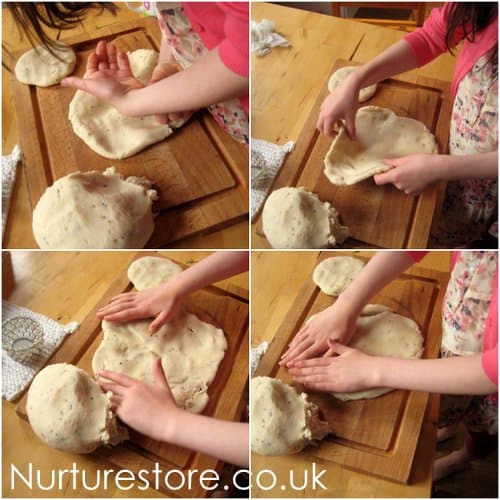
Once the ingredients had combined it was time to knead the dough.
This is such a comforting process, as the dough is still warm and each push and squash releases the fragrance from the herbs.
What children are learning about as they play:
:: the principles of making bread
:: gross motor skills
:: developing finger strength and dexterity.
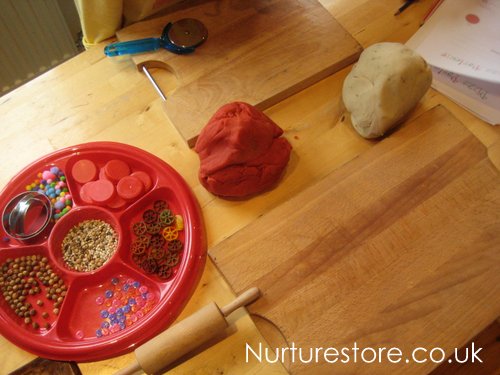
Then it was time to make pizzas!
We set out our restaurant kitchen on the table, with different stations: a place to take orders, boards where the children could roll out their pizza bases, a ‘toppings’ assortment and baking trays at the other end, so their pizzas could be taken off to bake in our toy cooker.
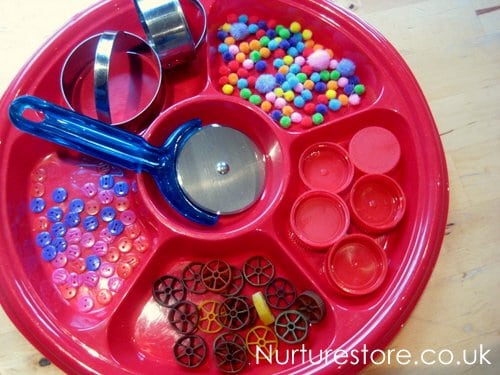
Items to offer the children as topping for their pizza could include:
:: pompoms
:: bottle tops
:: pasta pieces
:: buttons
:: marbles
:: dried beans
:: rice
:: lentils
:: fresh or dried herbs
You know your children so pick items to suit them ~ nothing small enough to swallow if you have young children playing
What children are learning about as they play:
:: using imagination
::thinking creatively
:: trying out a real life situation in play
:: co-operating with others
:: sharing
:: working as a team
:: counting
:: making choices and decisions
:: picking up small items: fine motor skills
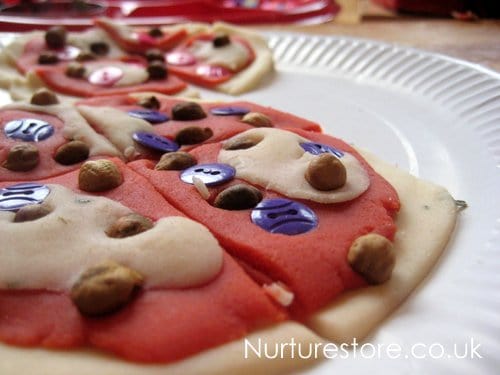
Including chopped herbs in the dough and a variety of toppings to choose from introduces lots of interesting textures to the children’s play – so much more interesting than only playing with plastic toy food.

The addition of a telephone gave the game a whole new twist – people could ring in to place pizza orders!
We worked together to make some Pizza Parlour order sheets, so the children could take notes of each order to pass to the pizza chefs.
This brought new elements to the play: reading, writing and having telephone conversations.
There was much excitement when I sneaked into the other room and called our home phone from my mobile to place a real order! {L whispered to B: It’s mummy in real life and she wants a pizza!}.
What children are learning about they play:
:: communication
:: real life situations: how do you answer the telephone /order a pizza
:: reading and writing
:: size comparisons: small, medium or large pizzas
:: how addresses and telephone numbers work
:: team work.
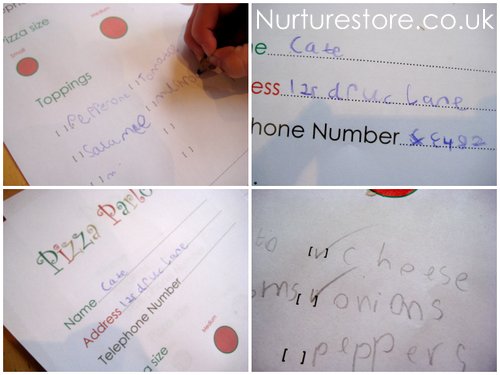
So much lovely writing going on ~ and all with a very practical purpose in the play.
If you’d like a template of the sheet we used you can download one here.
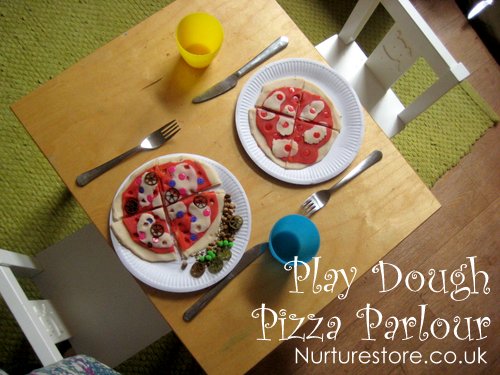
Setting up a simple restaurant area completed our Play Dough Pizza parlour and gave the children another aspect to include in their play ~ with lots of conversations going on as they took care of their customers.
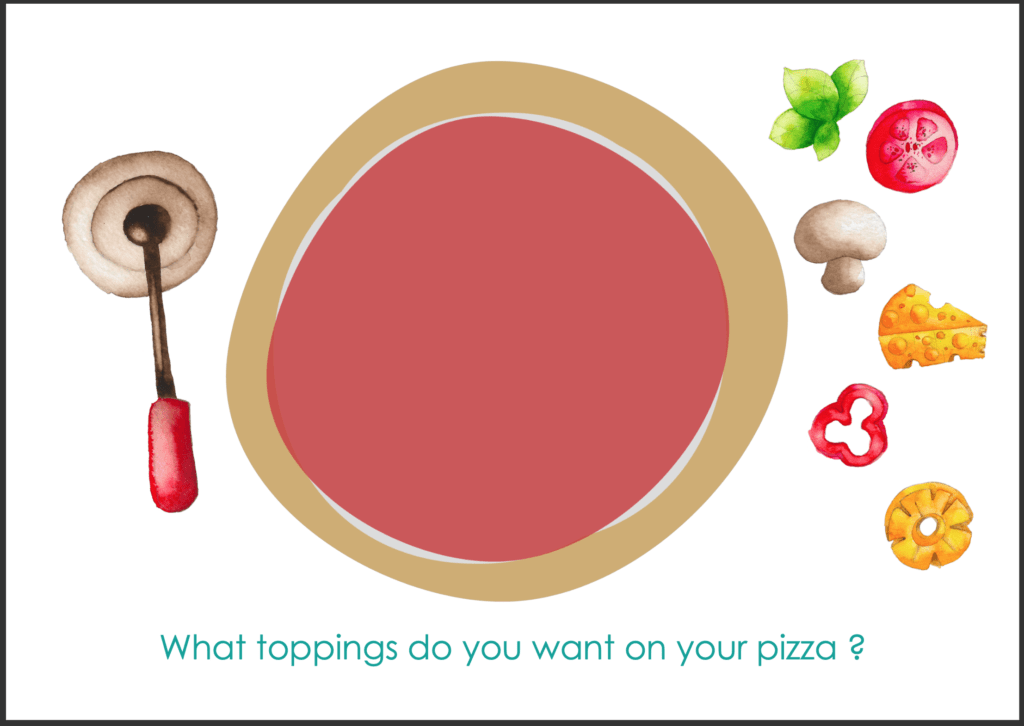
Download your copy of The Amazing Play Dough Printables Pack and get this fun pizza play dough mat. Your children can use play dough to add all their favourite toppings!
The Amazing Play Dough Printables Pack gives you a whole year of brilliant play dough play mats. You’ll always have an activity on hand. Simply print a mat, add play dough, and play!
Click here to get your set of Amazing Play Dough Printables!
by Cathy James
Do your kids love LEGO®? Just manipulating the pieces, snapping them together and pulling them apart is a great work out for fingers, helping to develop fine-motor skills, but Lego is a classic open-ended toy that can be used in so many different ways by creative kids. My girls most often use their Lego to build imaginary buildings or enclosures for their toy animals but recently L has been using them in lot of math games.
by Cathy James
Let’s make this winter the year when we delight in the cold and the dark.
Gather your children, get cosy, and make memories and connections together.
I’ll show you how with this guide to a cosy and connected winter:
…. CLICK HERE FOR YOUR GUIDE ….
![]()
by Cathy James
Day three of fairy week, and today I’ll show you how we made an imaginary play fairy land.